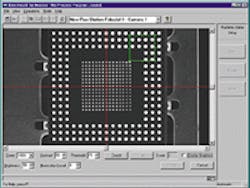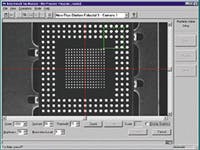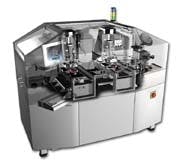Machine vision ensures quality BGA placement
Introduced by Motorola in the early 1980s, the ball grid array (BGA) was impractical for most assembly operations because of the amount of rework and cleaning required. Improvements in reflow technology and the trend toward no-clean or low-clean processes and electronic miniaturization have moved BGA technology from obscurity to prominance. Introduced by Motorola and IBM in plastic and ceramic forms, the BGA has grown to be a practical necessity as the cost of production has decreased and the demand has increased. As all types of electronic devices have grown smaller, area array packages of BGA and ChipScale (CSP) have become necessities to satisfy increased power and miniaturization requirements.
Early BGA standards have evolved into a myriad of custom sizes and arrays. Chip-scale packaging and 12-mil spheres with 20-mil pitch have become commonplace. The viability of these miniature BGA packages is dependent upon flux performance, reflow systems, and cleaning equipment, and, in part, upon the ability to assemble these packages reliably and efficiently.
At Speedline Technologies' Camalot Division (Haverhill, MA), the company has addressed the challenges of area array package BGA production in its Matrixx BGA and CSP sphere-placement system. In operation, BGA or CSP packages are moved on a strip, Auer boat, or JEDEC tray to a fluxing gantry where transfer pins apply the flux. Trays then move to a second gantry where solder spheres reside in a preinspected carrier above the BGA package.
After the carrier and BGA package are aligned, placement pins provide individual positive forces onto each sphere. As the spheres are pushed down through the carrier, the carrier guides them to alignment through the flux and onto the BGA pads. This prevents the sphere from floating on the flux and becoming displaced during reflow. The positive placement eliminates the traditional issues of a gravity-fed, free-falling sphere-placement system.
To develop the Matrixx system, the company adapted Windows NT-based software from its Xyflex multihead dispensing system. Xyflex software was built using the Matrox Imaging Library (MIL) development toolkit from Matrox (Dorval, Quebec, Canada). Using the MIL application programming interface, the software design team reconfigured the vision algorithms for use in the Matrixx Camalot.
Prior to placing flux or spheres on the substrates of the area array package ball-grid array (BGA), fiducials are aligned so that BGAs or chip-scale packages can be aligned with the ball-placement mechanism of the system.
"The MIL was used for the Matrixx product because Speedline had the MIL for the Xyflex software," says Jonathan Bloom, Speedline's software consultant. "In operation, the Matrixx system uses a TM-1300 camera from Pulnix (Sunnyvale, CA) to view images that are then captured by a Matrox Meteor-II digital frame grabber."
After the BGA or CSP package is inspected for the accurate application of flux, the preloaded carrier of spheres is checked to ensure all the spheres are present and the BGA package is aligned to the carrier for precise sphere placement. To check whether all the spheres are present and correctly placed, blob analysis was initially used. Ultimately, Matrox developed an algorithm for this task that was then added to the MIL.
Images taken during the BGA solder sphere placement show which part is missing, or whether there is an extra ball, a missing ball, or a ball out of tolerance. If a system problem emerges, the user is informed that maintenance is required.


